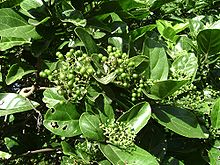|
Premna serratifolia
Premna serratifolia is a species of small tree or shrub[2] in the family Lamiaceae. It blooms and fruits between May and November.[3] During flowering season, it attracts a large number of butterflies and bees.[4] HabitatIt mostly grow in moist sandy soil and scrub jungles along seacoasts and mangrove forests.[3] In the Philippines, particularly in Cebu Island, it is usually found in the interior, watery forests of Southern Cebu. DescriptionTrees, to 7 m high. Leaves simple, opposite, estipulate; petiole 4–14 mm, slender, pubescent, grooved above; lamina 2.5-8.5 x 2–7.2 cm, elliptic, elliptic-oblong, base acute, obtuse, subcordate or rounded, apex acuminate, mucronate, obtuse, margin entire or subserrate, glabrous above except along the appressed midrib, chartaceous; lateral nerves 3-5 pair, pinnate, prominent, puberulous beneath; intercostae reticulate, obscure. Flowers bisexual, greenish-white, in terminal corymbose panicled cymes; bracts small; calyx small campanulate, 2 lipped, 5 lobed; corolla tube short, villous inside, lobes 5; stamens 4, didynamous, inserted below the throat of the corolla tube; anther ovate; ovary superior, 2-4-celled, ovules 4; style linear; stigma shortly bifid. Fruit a drupe, seated on the calyx, globose, purple; seeds oblong.[3] Medicinal usesThe plant is extensively used in Indian traditional medicine. Studies on the root wood of P. serattifolia led to the isolation of acteoside, a glucoside derivative.[5] The root bark of the plant which showed biological activities have also shown to contain a potent cytotoxic and antioxidant diterpene, 11,12,16-trihydroxy-2-oxo-5-methyl-10-demethyl-abieta-1[10],6, 8,11,13-pentene.[6] Culinary usesIn Vietnam, the aromatic leaves of P. serratifolia are used to cook in some braise or stir fry dishes with chicken, eels or frogs.[citation needed] References
Further reading
|
||||||||||||||||||||||||||||||||||||||

